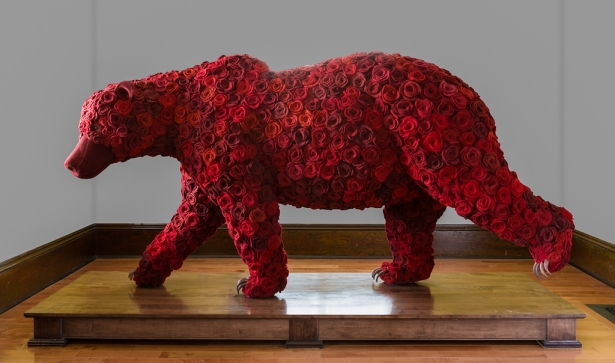If you have only recently discovered this little gem of a blog then you
may not know the affinity I have for coyotes and taxidermy. Any time I see an artist
using coyotes or coyote forms or any taxidermy "ephemera" really, I sometimes develop a little art crush. I usually end up spending a couple hours exploring an artists website and making notes and then in most
cases, they end up posted here. and again, I have stumbled or linked my way to the amazing and incredible Janice Wright Cheney.
I think I have mentioned my affinity for coyotes and animals and taxidermy. Janet's work is interesting because while her wolves/coyotes sometimes look more like weimaraners than wild animals I think it is intentional because her work blurs the lines between wild and domestic, as well as gender.Much of Janet's work involves combining a traditionally female craft (embroidery, tatting, knitting) with a form that suggests masculinity: the taxidermy form. The foam "carcass" is dressed up in "female" attire complete with jewellry and false eyelashes. The wild animals seem far more domestic in their lacy scarves and fur which appears more of a fashion statement than as a representation of them in thier "natural" state.
It is interesting too that the ladies (which is a total assumption since we can't see all of their anatomy) are only half dressed either half skinned or half covered depending and when juxtaposed with the bones of the actual animals in small boxes much like museum specimens the question really does become about what remains. Placing these creatures out in a natural environment makes the question even more haunting.
The felted flower covered bears are titled Widow and represent loss, grief and survival. A taxidermied bear is often posed in an aggressive stance speaking with some suggestion tot he prowess of the hunter who killed it. I have never seen a bear trophy mounted to depict a bear lost in thought or simply sitting and admiring its surroundings. These bears simultaneously represent the trophy, the monument, the conquer and yet something more delicate- a sadness, a memorial, a burial ritual. The flower covering the bears is a rose, hundreds of hand felted red, pink, and burgundy roses the flower of love. Generally the red rose is symbol of romantic love and the title hints at this loss as well "widow" suggesting the loss of a husband. What fascinates me even more is that bears do not mate for life – they do not marry, they do not have the matrimonial bond of humans nor do they even co-habitate yet there is no questioning the love and bond between a bear and her cubs. And that leaves me wondering if there is a subtext at play that perhaps the bear has suffered a loss and is more than simply a momunment to the fear and conquer human trophy.















No comments:
Post a Comment
Note: Only a member of this blog may post a comment.